By Dustin Cabeal
Well, it’s unlikely that I’ll continue reviewing this series. It’s already settled into its rhythm, and while that’s great for people that are enjoying it, I’m still finding it to be average. Sometimes painfully average.
Read More
Well, it’s unlikely that I’ll continue reviewing this series. It’s already settled into its rhythm, and while that’s great for people that are enjoying it, I’m still finding it to be average. Sometimes painfully average.
Read More
Growing up, I never had an imaginary friend. Not sure what that says about me but I just never did. But I do remember my sister having one. It was this fat little baby looking-thing named Chebby or something like that. I also remember trying to play with them, my sister and Chebby were always getting up to something, but she never let me. She’d always say that Chebby didn’t like me or that it (he?) was mad at me or that it hated me. My sister was older than me and was never really nice when we were kids.
Read More
Vertigo joins together veteran horror writer Tim Seeley (Hack/Slash) and artist Stephen Molnar (Star Trek) to create a spine-tingling new series, IMAGINARY FIENDS. The six-issue miniseries combines elements of both horror and sci-fi for a tale that will leave readers in shock and fear.
Read More
The world is feeling the Wonder Woman fever as her solo movie takes over the box office, what better time to have new comics that readers can jump into without much need for knowing years of her background. That’s what I was looking for from Wonder Woman: Steve Trevor #1, an action-packed story that would shed more light on Steve Trevor and show why he’s important to Diana. What I ended up with were mixed emotions and sadly a sense that this comic will have no lasting impact on me. While Steve Trevor does get to fight bad guys and save the day all on his own, it’s weighed down by a lot of internal monologuing and dialogue moments that ruined my sense of immersion.
Read More
There’s an experiment you can play while reading Tarzan on the Planet of the Apes, every time the current tension has played out and they’d need to cut away to move forward—stop on that page.
Then, as you slowly turn the page, see if the next one has dinosaurs attacking.
Read More
The Lost Boys is one of my all-time favorite movies. I absolutely love it. Imagine my surprise, if you will, when I find out that Vertigo were putting out a comic book set in the movie universe. I had to give this one a go, just to see how they’d handled it. The story opens in Santa Carla and we’re given a little backstory about what happened in the movie. We meet the Frog brothers and Sam and Michael again. They’re all getting on with their lives. Michael’s working in a nursing home and Sam works in the local comic shop now. The Frog brothers are being the Frog brothers still, now receiving trained from Sam and Michael’s Grandpa. There’s loads of chit chat in this and then we get to Grandpa Emerson and his Santa Carla Hunter’s Society having a meeting, which is soon interrupted by some vampires… I’ll leave it there. No spoilers from me, bro.
Read MoreWhen I was growing up, I had two great science fiction loves: pulp and 1960s sci-fi. I was obsessed with the words of Bradbury, Heinlein, and Philip K. Dick—these stories that felt injected with brave new ideas and strange worlds. This was a love that contrasted sharply against the crude simplicity of the pulp genre—the weird, tongue-in-cheek nature of the Green Hornet and his gun that melted other guns, the invincible brilliance of Doc Savage. They were contradictions that together I'd willingly live with. Planet of the Apes, however, was a totally different beast. It was a movie that managed to merge the far-flung traveler archetype of Edgar Rice Burroughs with a narrative that challenged the stability of our own society and highlighted the cyclical nature of violence and subjugation that every society inevitably creates. A movie that taught that long as there’s power to be held, the people with it will do whatever is necessary to keep it, even if those people are hyper-intelligent apes.
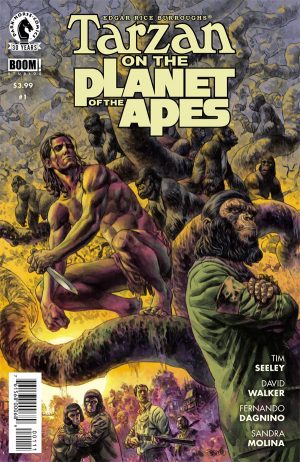 Despite the restrictions of its initial premise, the Planet of the Apes as a film series proved to be one of the weirdest and most flexible series in film. The series moved from the strange dystopia of the original, the mutant cult of the atomic bomb of the sequel and then to the time travel politics of the third.
Despite the restrictions of its initial premise, the Planet of the Apes as a film series proved to be one of the weirdest and most flexible series in film. The series moved from the strange dystopia of the original, the mutant cult of the atomic bomb of the sequel and then to the time travel politics of the third.
So when this comic proposed a crossover between Planet of the Apes and Tarzan, it felt like one of the most natural things in the world. Tarzan is more-or-less exactly what the humans were in the original movie. They were half-naked pale dudes with long hair and bad English so contrast that archetype with the time travel at the end of the second film; it seems so easy for the two ape scientists, Zira and Cornelius, to crash land in Tarzan’s jungle instead of the contemporary Washington D.C. like in the third film.
That's where the comic begins chronologically. Tarzan, the orphaned child of some British people, is raised in the early 1900s not by a family of gorillas but by the temporally displaced ship crashed scientists from a strange and possible future. Raised, that is, alongside their son Caesar.
The art here looks pulled straight from the old covers of classic pulp novels. There are these soft colors over detailed and lush linework that captures both the mythical jungle backdrop of Tarzan with the iconic designs and faces of the original Planet of the Apes movie. After the recent Apes movies with the hyper-realistic CG monkeys, getting to see the original make-up designs again now more emotive than ever took me in a wave of nostalgia.
With two franchises as old as these and as frequently reinvented as these, Tarzan on the Planet of Apes tells a story that feels both new and respectful to where these series came from. If there’s any even higher praise I can give this comic, it’s that this is the first time I’ve ever liked Tarzan as a character.
I was the perfect age for the animated Disney Tarzan movie when it came out, and still, I hated it. Maybe it was the Phil Collins music; maybe it was that Tarzan is, and always has been, built upon dated and racist concepts. More likely though it was because I’ve always hated characters who understood less than I did. Even as a kid, I hated seeing character who were not children still be infantilized. I do not want to see a grown man learn what a book is or learn the word, love. Here in this story, having him be raised by people who are educated, who know literature and science is a revelation. Finally here is a Tarzan that’s a kid only when he is actually the proper age to act like a kid.
Suddenly Tarzan’s family situation feels so much more real than it ever has. Tarzan and Caesar act like two kid brothers playing around, Zira and Cornelius act like caring parents, and I’m so much more emotionally grounded than I could have expected.
That means that when the story goes dark--when the poachers start hunting their gorilla prey, it’s so much more brutal and scary. The artists here balance the harsh and sickening reality of poaching without ever making it gratuitous. When the gorillas are injured from rifle wounds, it’s awful and stomach churning but never feels exploitative. There's no pouring guts or garish detailed wounds but the details we get hurt more than disgust.
We feel the weight of poaching even in a world of talking monkeys, and this creates villains that feel equal parts despicable and dangerous. There’s no guarantee here that Tarzan and the others will get away unscathed and they don’t.
The issue begins and ends in medias res and far away from the dangerous threats of the past. Tarzan’s fully grown and he feels invincible, and it’s this and what positions to be the central plot where I'm let down. The writers and artist here do so well in grounding this as a story about family and the very real threats to them, that when they start introducing the fractured space-time and enemy future ape armies, it’s hard to keep caring.
The plot points almost feel like an obligation--a lip service to the bombastic pulp nature of Tarzan to set up something that'd make for a good action movie. But this comic made me not want an action movie. Tarzan’s destined to be a human hero and Caesar an ape revolutionary and seeing this origin of a relationship, this united history, made me want to see where their natural paths would end and which side of a war they’d stand on.
I want that story, and if this miniseries is willing to offer it, I’m ready to follow it to the end.
[su_box title="Score: 4/5" style="glass" box_color="#8955ab" radius="6"]
Tarzan on the Planet of the Apes #1 Writer: Tim Seeley & David F. Walker Artist: Fernando Dagnino Colorist: Sandra Molina Publisher: Dark Horse Comics Price: $3.99 Format: Ongoing; Print/Digital
[/su_box]
The review for Oblivion #1 was my first review for this site. I deliberately picked out something that I thought I'd enjoy for the sake of starting on a positive note and it let me down hard. It was strangely paced, a bad introduction to newcomers and a boring slog for anyone familiar enough with the source material to not need every character reintroduced for this one. I picked up Oblivion #2 because I actually didn't think it was beyond salvation. Comic books are short and judged by their chapters. In doing so, I think Oblivion #1's faults came in trying very hard to make its first issue worth the asking price and to hype up its audience. Pacing a comic book by 20-30 pages a reading session is extremely difficult. So I'm back to see what Oblivion does with this extra leg room it has.
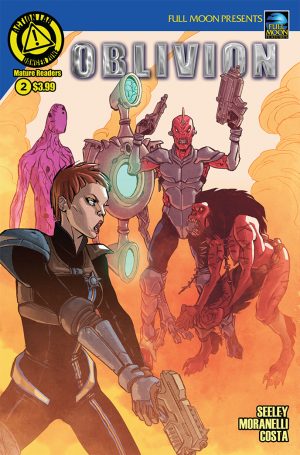 As I was hoping, yes, this issue is better. It's not bogged down in re-introduction, the strange matter of pacing regarding the writing's insistence on not allowing its art to do its job conveying information has vanished as if the writer and artist had some time to be friends, maybe grab a cup of coffee between issues, work out their, well, issues and form a burgeoning relationship. The storytelling is better, information is doled out evenly between quiet, dialogue-driven sections, and the art is perfectly serviceable in the job it should have been given from the start.
As I was hoping, yes, this issue is better. It's not bogged down in re-introduction, the strange matter of pacing regarding the writing's insistence on not allowing its art to do its job conveying information has vanished as if the writer and artist had some time to be friends, maybe grab a cup of coffee between issues, work out their, well, issues and form a burgeoning relationship. The storytelling is better, information is doled out evenly between quiet, dialogue-driven sections, and the art is perfectly serviceable in the job it should have been given from the start.
This is the issue in which having enjoyed the movie it's based on isn't so much a requirement as a strong suggestion. Characters speak as though we already know them, alleviated somewhat by the occasional inquiry or conversation topic brought up by our female lead, a scaly green lizard-lady. However, the two villains so far are intriguing in setting up two different methods for allowing for character development. The first is a gross red alien with an extremely phallic protrusion coming out of his head who gets a great deal of back-story and dialogue to flesh out his personality. The second, a black-haired dominatrix who's character is so ingrained into her dialogue and actions that it's impossible not to get a read on her character. In contrast, the heroes appear bland and uninteresting.
Despite the obvious improvements, I'm loathe to give this issue any higher than a three out of five in that it doesn't seem to be leading to anything of any consequence. The drama falls flatter than a lead pancake as we finally begin to understand the villain's plot, which involves a magical altar that makes people magically tune out after hearing the word magical altar. The heroes don't even have a read on the concept that the bad guys could be up to something of any meaning to anyone as they are transfixed on the curse that has befallen our female lead. This is the structure of a mid-day sitcom in which two stories, an A story and a B story provide appropriate pacing to maximize laughs while minimizing the effects of prolonged exposure to any one situation, except that there are no laughs.
If the characters were simply a little more fun to be around, it would get a recommendation out of me. If I felt as though the characters had something to accomplish other than, so far, nothing, then I would give it a recommendation. I don't have a reason to be compelled to pick up the next issue. If there's something that Oblivion gives you that I'm not getting, then by all means pick it up, it's a vast improvement on issue #1. But until I figure out why someone would want to continue besides pure nerd-appeal, which I totally get but don't believe to be a selling point, then I'm going to have to give it a solid, resounding "lukewarm."
As resounding as "lukewarm" can be, anyway.
[su_box title="Score: 3/5" style="glass" box_color="#8955ab" radius="6"]
Oblivion #2 Writer: Tim Seeley Artists: Romina Moranelli Colorist: Marcelo Costa Publisher: Danger Zone Price: $2.99 Format: Ongoing; Print/Digital
[/su_box]
Nightwing's plan -- such as it is -- seems hugely flawed. He's going to infiltrate the Parliament of Owls, a secret criminal society, for the sake of betraying them. Okay. But they know he's going to betray them. And Dick seems to know that the Owls know he's going to betray them. The relationship creates a fun, intriguing tension between two parties engaged in a potentially elaborate dance, each waiting for the other to show a weakness. In this issue, Dick touches base with his support system to get his father's approval. And he is denied. It's a great moment of Batman being a good bat dad. His bat resources are always at Nightwing's bat disposal, but Dick has to own any victories or failures resulting from his dumb plan. It seems like Nightwing's search for Batman's approval should have been resolved years ago. Even factoring in DC's sliding time scale, Dick Grayson is an experienced hero. Faking his death let him redefine himself. And now he's doing it again because... because.
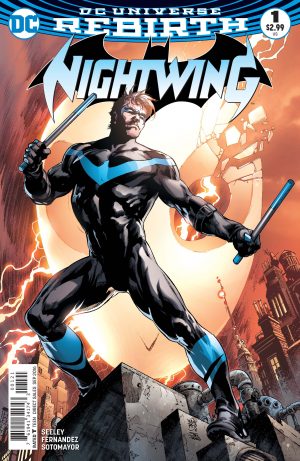 Nightwing is learning his limitations, finding the boundaries of his competence as a solo hero. He thinks he's in control of his relationship with the Parliament of Owls, but this issue makes it clear that there's always another threat in the world of super heroics. Dick Grayson is not as in control of his life as he wants to believe.
Nightwing is learning his limitations, finding the boundaries of his competence as a solo hero. He thinks he's in control of his relationship with the Parliament of Owls, but this issue makes it clear that there's always another threat in the world of super heroics. Dick Grayson is not as in control of his life as he wants to believe.
Hopefully writer Tim Seeley can make a strong mark on this character that survives the next inevitable DC continuity wipe. That's the problem with the ephemeral nature of DC canon: character development never has enough traction to really warrant your passion. Relationships grow and regress, experiences get wiped away, and stories get retold to the point of becoming diluted. Nightwing probably shouldn't be this hung up on defining himself. You can sense it in his attitude. When approaching his "bosses" in the Parliament of Owls, Dick is all bluster and attitude. It’s a fun show, but ultimately ineffective. Naturally, the Parliament is going to try putting him in his place under their collective thumb. Issue one makes it clear that Dick gets a lot of joy from taking risks. It's entertaining. But it feels a bit like backsliding, like Dick is trying to return to a comfort zone of flippancy and thrill-seeking.
The premise for this new volume comes across as writer Tim Seeley playing around with our hero's sense of vulnerability. So, by necessity, the writing feels like it’s performing without a net. We’ll see how that works out.
[su_box title="Score: 3/5" style="glass" box_color="#8955ab" radius="6"]
Nightwing #1 Writer: Tim Seeley Artist: Yanick Paquette Colorist: Nathan Fairbairn Publisher: DC Comics Price: $2.99 Format: Ongoing; Print/Digital
[/su_box]
During my read of Oblivion #1, I asked myself what I had been missing. There was once a time I would skim through a comic, eyes blazing past the words in an effort to absorb small tidbits of information as they were plainly given, but even after a thorough examination of each individual panel, I felt as though I had regressed back to my middle-school days of attempted speed-reading and hyper-consumption. After finding that I had not missed some hidden intricacy in between the lines, I turned toward the material surrounding this book, and it appeared that I was correct. I somehow had managed to avoid the crucial fact that Oblivion is a sequel, or rather a reboot if we're to believe the implications of its "A Rose By Any Other Name" naming convention. The movie was entitled Oblivion and was directed by Sam Irvin. I've not seen the original film, but after a cursory glance at the trailer, I feel prepared to say that this initial issue for a re-branding is not worth its asking price.
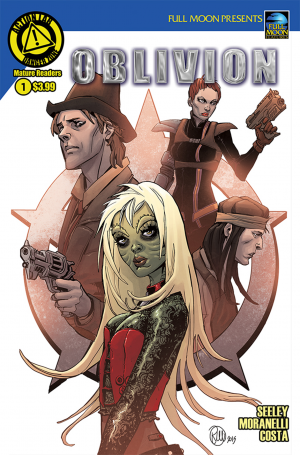 There's a strange line between writing and art where comics exist that must be paid constant attention. Inside that line, where art, action, and dialogue form the panels of a comic, exists the concept of conveyance, and it is this concept of conveyance where I find Oblivion #1 fails greatest. While neither the writing nor the art are sub-par, in fact even excellent at times, the two never connect to create meaningful imagery or to accurately convey the emotion or even the actions behind a scene. The writing seems to assume the art is incapable of capturing moments such as a phone being dropped to the ground or the violent reaction of an angry mob.
There's a strange line between writing and art where comics exist that must be paid constant attention. Inside that line, where art, action, and dialogue form the panels of a comic, exists the concept of conveyance, and it is this concept of conveyance where I find Oblivion #1 fails greatest. While neither the writing nor the art are sub-par, in fact even excellent at times, the two never connect to create meaningful imagery or to accurately convey the emotion or even the actions behind a scene. The writing seems to assume the art is incapable of capturing moments such as a phone being dropped to the ground or the violent reaction of an angry mob.
As a consequence, the art is never given the leeway to capture said moments and thus, the decades old problem of an artist attempting to make long, moody conversations visually interesting exists in a comic that is all but screaming to be visually interesting. The closest this issue gets to a moment of visually exciting and contextually thrilling action is a brief fight with violent prostitutes that is both crippled by its briefness in the larger scope of the issue and a lack of visceral motion in the characters movement, leading to a particularly frustrating moment where a character rears her head back for a reverse-headbutt with little visual indicator to impact while the aforementioned character spouts overly-long exposition (“My Dad was an interstellar criminal who left orphans across seven systems...”) only to lead to a clunky payout in the panel after the headbutt has stopped being relevant to the character's proof of competence. (“You think I don't know how to defend myself?”) In fact, the comic as a whole seems to believe that exposition is a competent replacement for banter, character moments or actions.
It's difficult to find myself not dwelling on the negative when the issue as a whole is so poorly conveyed as to be not frustrating or thrilling, but rather boring. Characters and concepts are introduced quickly and without meaningful impact and I was left feeling as though I should be taking notes rather than enjoying myself. This may be different were I to recognize the characters from the 1994 film, but these introductions, if fan-service they must be, do not act as seminal moments in which to brazenly introduce characters that had once brought me joy, but rather as cliffnotes to hurriedly remind me that I don't need to spend my time reintroducing myself so we can get to the characters who matter.
Oblivion #1 comes alive for a brief moment in the prostitute fight where the art and writing come together to create a single punchline involving a prostitute being "given a new john" while having been slammed into a toilet. Otherwise, I would be wary of recommending this even to fans of the original movie, for if the original was good enough to deserve this sequel, then this comic should be devoted more to retaining the fun and campy excitement of the film rather than slowing down to remind me that the film existed.
I understand this may be a harsh review for a first issue to a previously established franchise, but I also believe that working within that same previously established franchise should be license to skip right to the fun parts, rather than to slow down the chain of events with lazy fan-service that exists to piggyback off of the original rather than to create exciting and unique moments of its own.
[su_box title="Score: 2/5" style="glass" box_color="#8955ab" radius="6"]
[/su_box]
Writer Tim Seeley would like to introduce you to Dick Grayson. Nightwing: Rebirth attempts -- as does seemingly all Rebirth books -- to place its title character on solid ground after years of uncertainty. After some time working as a spy, life-long superhero Dick Grayson is looking to reconnect with his superhero identity. I find it difficult to discuss Nightwing without mentioning Batman. So… I'm going to go ahead and mention Batman a few times.
Dick Grayson is one of DC's stronger characters depending on how you view his canonical history. He has gone from loyal sidekick to smarmy leader to capable solo act. Dick is frankly a better man than his father Bruce. The former does not share the latter’s inability to move on from grief. Nor does Dick seem stifled by the hard reality that Batman’s war on crime can never be won. If 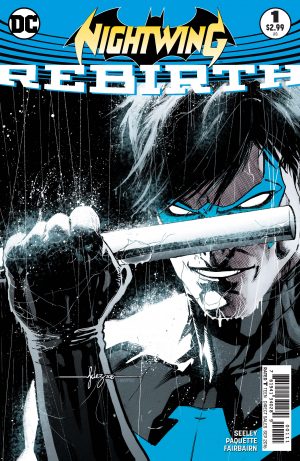 Bruce ever came to terms with that reality, he'd retire from his role as the Caped Crusader. Dick Grayson has better, more relatable reasons for enacting his vigilante justice.
Bruce ever came to terms with that reality, he'd retire from his role as the Caped Crusader. Dick Grayson has better, more relatable reasons for enacting his vigilante justice.
Dick has friend and not just allies. This makes Seeley’s run promising from a character driven standpoint. For example, Nightwing has to protect his brother Damian from an evil cult of pompous bird-worshipers. Also there's the fact that said evil cult wants to make him their dark messiah or something. There’s no vague goal here. Nightwing’s family is in danger, so he does must to protect them. Grayson seems determined to shine some light into the darker parts of Damian's soul. The kid comes from violence and struggles to prove himself to his father. Seeley’s writing is at its best with theses two brothers, though sometimes a bit Silver Age stiff and awkward.
If nothing else Nightwing in Rebirth stands as a much needed counterpoint to his father/mentor. Batman has allies; Nightwing has friends. He works in darkness but does not live there. As a man forged by tragedy and uncertainty he could devote himself to beating order into chaos. But instead, Dick's ambition lies elsewhere. Yanick Paquette’s often playful art convinces you that Grayson loves being a hero. Nightwing’s cocky grin is a lot of fun to see amid a sea of brooding, stoic faces.
Rebirth appears to be Dick's opportunity to redefine his place in the Bat Family. Out of fiction, it's obviously a chance for DC to backslide and reestablish the commonly held status quo. And that's not necessarily as negative as it could be. With Nightwing: Rebirth Tim Seeley operates within the narrow confines of DC's ever-changing canon. Seeley takes what we know about Dick -- that he is a deeply moral thrill-seeker, a thinker, a concerned brother, a devoted but independent son, and a valuable friend -- and he makes that the driving impetus for Nightwing's new-ish direction. This book is a look back that informs a lot of what’s ahead.
This is an excellent intro to the life of Dick Grayson. And it does an exceptional job teasing future storylines.
[su_box title="Score: 4/5" style="glass" box_color="#8955ab" radius="6"]
[/su_box]